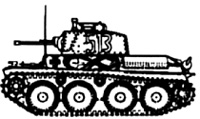 Of all the "first divisions" of the Second
World War, the 1st Armoured Division of the
British Army is one of the most obscure.
Beginning life in 1938 as the first big British
tank unit, the "Mobile Division," it never
reached the fame and prominence that one
might have expected of the first armored
division of the nation that invented the tank. It
certainly never received the acclaim of its
erstwhile running mate, the "Mobile Division
Egypt," alias the 7th Armoured Division.
Of all the "first divisions" of the Second
World War, the 1st Armoured Division of the
British Army is one of the most obscure.
Beginning life in 1938 as the first big British
tank unit, the "Mobile Division," it never
reached the fame and prominence that one
might have expected of the first armored
division of the nation that invented the tank. It
certainly never received the acclaim of its
erstwhile running mate, the "Mobile Division
Egypt," alias the 7th Armoured Division.
At the start of the war the 1st Armoured Division had a tank-heavy T/O with 1st Light Armored Brigade (three cavalry "regiments" in light tanks), 1st Heavy Armored Brigade (three battalions of the Royal Tank Regiment in cruiser tanks) and 1st Support Group with two motorized infantry battalions, two regiments of Royal Horse Artillery, "RHA" (i.e., two motorized field artillery battalions), a light anti aircraft- antitank battalion and an engineer company. 2nd Light Armoured Brigade (more cavalry regiments in light tanks) was attached.
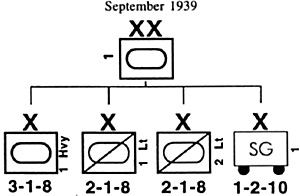 Unfortunately, years of neglect had left
their mark, and the 1st Armoured Division was
far from combat worthy, resulting in the virtual
dismemberment of the division. First, the two
RHA regiments were detached for duty with
the British Expeditionary Force. Then the two
infantry battalions of the Support Group were
used to form 30th Infantry Brigade and
destined for Norway. When "Fall Gelb"
commenced, this brigade, reinforced with the
cruiser tanks of 3rd Royal Tank Regiment (3rd
Armoured Brigade), was sent instead as a
forlorn hope to defend Calais. Only the
personnel of the tank battalion escaped.
Unfortunately, years of neglect had left
their mark, and the 1st Armoured Division was
far from combat worthy, resulting in the virtual
dismemberment of the division. First, the two
RHA regiments were detached for duty with
the British Expeditionary Force. Then the two
infantry battalions of the Support Group were
used to form 30th Infantry Brigade and
destined for Norway. When "Fall Gelb"
commenced, this brigade, reinforced with the
cruiser tanks of 3rd Royal Tank Regiment (3rd
Armoured Brigade), was sent instead as a
forlorn hope to defend Calais. Only the
personnel of the tank battalion escaped.
Meanwhile, after the first of many revisions in its T/O (the armored brigades received identical T/Os of cruiser and light tanks), the rest of the division had been sent to France for more training. Now, in face of the German offensive, "a badly mutilated formation" (in Liddell-Hart's words) had to be committed. 2nd Armoured Brigade (formerly 1st Light Armoured), with three cavalry regiments, arrived first, followed by 3rd Armoured Brigade (ex-1st Heavy Armored Brigade), with only two battalions, and the skeletonized 1st Support Group. The division went into action on May 27, 1940, fought Rommel in early June and then escaped with its personnel and some tanks from Cherbourg on June 18th.
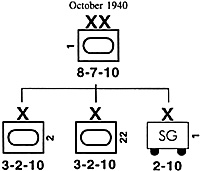 The division reformed to defend against
the threatened German invasion. Under a third
T/O the division now had two armored
brigades: 2nd and 22nd (composed of
Territorial Army yeomanry regiments), each
with three tank battalions and one motor
battalion; 1st Support Group with one infantry
battalion, one RHA battalion, one AT
battalion and one LAA battalion; and 12th
Lancers, an armored car battalion for
reconnaissance. Because 1st Armoured
Division was still recovering from the debacle
in France, the 2nd Armoured Division (which
included 1st and 3rd Armoured Brigades) went
overseas first and was wrecked in Rommel's
1941 offensive.
The division reformed to defend against
the threatened German invasion. Under a third
T/O the division now had two armored
brigades: 2nd and 22nd (composed of
Territorial Army yeomanry regiments), each
with three tank battalions and one motor
battalion; 1st Support Group with one infantry
battalion, one RHA battalion, one AT
battalion and one LAA battalion; and 12th
Lancers, an armored car battalion for
reconnaissance. Because 1st Armoured
Division was still recovering from the debacle
in France, the 2nd Armoured Division (which
included 1st and 3rd Armoured Brigades) went
overseas first and was wrecked in Rommel's
1941 offensive.
1st Armoured Division finally followed, again piecemeal, in late 1941, with 22nd Armoured Brigade arriving in time to fight as an independent unit in the British November 1941 offensive, "Operation Crusader."
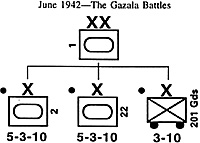 Finally assembled in Egypt, the
division went into battle with both armored
brigades, the support group and the attached
200th (formerly 22nd, soon to be 201st)
Guards Brigade, in January 1942.
Finally assembled in Egypt, the
division went into battle with both armored
brigades, the support group and the attached
200th (formerly 22nd, soon to be 201st)
Guards Brigade, in January 1942.
Unfortunately, it was routed in Rommel's 1942 Offensive and was driven back to the Gazala defenses by Tobruk. Again it was reorganized, in line with 8th Army's "Jock Column" ideas, into independent brigade groups composed of armor (2nd and 22nd Armoured) or infantry (201st Guards) with artillery and engineers attached. In this fashion, it faced Rommel again in the June 1942 "Gazala Battles." With a fragmented organization, the division suffered heavily but made a fighting retreat to the Alamein positions.
After participating in the initial Alam Halfa battles, the division was withdrawn to be re-equipped and reorganized once more. With the arrival of Montgomery, the brigade group and "jock column" era ended, the division became the basic battle formation.
Equipped with the new American Sherman tanks, 1st Armoured Division formed part of 10 Corps, Montgomery's "corps d'chasse," composed entirely of armored formations. The division now had 2nd Armoured Brigade and 7th Motor Brigade (formed from the 7th Support Group).
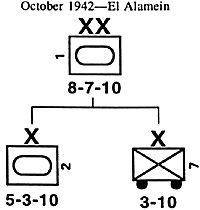 During the Battle of El Alamein, the
division suffered heavy losses in repeated
attempts to break the Axis lines. However,
once the long retreat began, the division fought
with Eighth Army all the way to Tunisia.
There it was transferred to the British First
Army for the final push on Tunis. On April 5,
1943, it underwent perhaps the ultimate
indignity when it was redesignated "Ist British
Armoured Division" to "distinguish" it from
the American 1st Armored Division ("Old
Ironsides") which was also serving in North
Africa.
During the Battle of El Alamein, the
division suffered heavy losses in repeated
attempts to break the Axis lines. However,
once the long retreat began, the division fought
with Eighth Army all the way to Tunisia.
There it was transferred to the British First
Army for the final push on Tunis. On April 5,
1943, it underwent perhaps the ultimate
indignity when it was redesignated "Ist British
Armoured Division" to "distinguish" it from
the American 1st Armored Division ("Old
Ironsides") which was also serving in North
Africa.
After the Axis surrender in Tunisia, the division was relegated to garrison duty in North Africa where it rusticated for almost a year. In 1944, the division went to war for the final time, piecemeal as before. 7th Motor Brigade, now known as 18th Infantry Brigade, was detached and sent to the Anzio Beachhead on February 17, 1944, to reinforce 1st Infantry Division. On May 27, 1944, after arriving by air from North Africa, division headquarters set up shop in Italy, where it joined 2nd Armoured Brigade, which had arrived by sea. 18th Infantry Brigade rejoined in August.
By this time, after two more reorganizations, the division was composed of four tank battalions, including 4th Hussars, the divisional armoured reconnaissance regiment; four infantry battalions (one in the armoured brigade and three in the infantry brigade), 2nd and 11th RHA (one motorized and one self-propelled artillery battalion), an antitank regiment, a light anti-aircraft regiment and three companies ("squadrons") of Royal Engineers.
The division's career in Italy was brief. It received 43rd Lorried Gurkha Brigade as its second infantry brigade as did the other British and Commonwealth armored divisions in this theater. Although it received some training before entering combat, the division was inexperienced and untrained in the unique warfare found in Italy. Its brigades were strangers to each other: 2nd Armoured Brigade had not been in battle for 15 months and the attached Gurkha brigade was fresh from garrison duty in Palestine and seeing action for the first time in the war.
Only the 18th Infantry Brigade had recently been in battle but only in static warfare on the Anzio front. There was some suggestion the old cavalry mentality had still not been shaken. All of the division's armored battalions were old and distinguished cavalry regiments: The Queen's Bays, 9th Lancers, 10th Hussars and 4th Hussars (Winston Churchill's old unit). Their companies were called "sabre squadrons," their tanks were called "mounts," and they weren't "knocked- out," they were "unhorsed." Even the infantry battalion in the armored brigade had started life as a Territorial Army yeomanry mounted unit in 1939, the Yorkshire Dragoons.
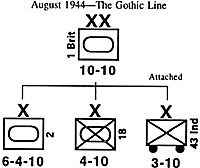 The division was thrown against the
Gothic Line and was decimated, especially in
an abortive charge across a river in the face of
dug-in 29th Panzer Grenadier Division. With
the desperate need for infantry reinforcements
and the difficult tank country, the division
ceased to be operational on October 28, 1944.
2nd Armoured Brigade went to 78th Infantry
Division, to make it the British equivalent of
the 2nd New Zealand Division, a mechanized
division with one armored and three infantry
brigades; 43rd Lorried Gurkha Brigade became
an independent formation; and 18th Infantry
Brigade was disbanded. The support troops
were reassigned or broken up to provide replacements.
The division was thrown against the
Gothic Line and was decimated, especially in
an abortive charge across a river in the face of
dug-in 29th Panzer Grenadier Division. With
the desperate need for infantry reinforcements
and the difficult tank country, the division
ceased to be operational on October 28, 1944.
2nd Armoured Brigade went to 78th Infantry
Division, to make it the British equivalent of
the 2nd New Zealand Division, a mechanized
division with one armored and three infantry
brigades; 43rd Lorried Gurkha Brigade became
an independent formation; and 18th Infantry
Brigade was disbanded. The support troops
were reassigned or broken up to provide replacements.
The 1st British Armoured Division was officially disbanded on January 11, 1945, having had no units under command for several months. This was an unfortunate but inevitable end to Britain's first armored division. In many ways, its wartime career symbolized the experience of the Royal Armoured Corps and indeed the British Army in World War II.
The 1st Armoured Division, like many British units, was unprepared and underequipped in 1939; it was many times reorganized as one new pet theory after another was tried, from Liddell-Hart's and Fuller's tank-heavy formations, through the "jock-columns" of the Eighth Army, to the infantry-heavy formations of Italy. The division was usually committed to battle piecemeal and when it wasn't, it was stagnating in garrison. Finally, like many of its fellow British armored divisions of the Second World War, it was disbanded before the final German surrender.
The 1st Armoured Division briefly reappeared after the war when 6th Armoured Division, on duty in Palestine, was redesignated as the 1st. Its latest incarnation came fifty years later in the Gulf War when the British forces of General Schwartzkopf's "Hail Mary" went into battle under the designation of 1st Armoured Division, whose component brigades, ironically, were the 4th and 7th Armoured Brigades, the designations of the original two armored brigades of 7th Armoured Division, "Desert Rats."
Bibliography
Crow, Duncan, editor; British and
Commonwealth AFVs 1940-1946; Garden
City, New York: Doubleday & Company,
Inc., 1972.
Friedman, Norman; Desert
Victory:The War for Kuwait; Annapolis:
Naval Institute Press, 1991.
Graham, Dominick and Shelford
Bidwell; Tug of War: The Battle for Italy,
1943-1945; New York: St. Martin's Press,
1986.
Jackson, W. G. F.; The Battle for
North Africa 1940-1943; New York:
Mason/Charter, 1975.
Joslen, H. F.; Orders of Battle;
London: Her Majesty's Stationary Office,
1960 (two volumes).
Liddell Hart, B. H.; The Tanks,
The History of the Royal Tank Regiment 1914-
1945; New York: Frederick A. Praeger,
Inc., 1959.
Orgill, Douglas; The Gothic Line;
New York: W. W. Norton & Company, Inc., 1967.
Back to Europa Number 33 Table of Contents
Back to Europa List of Issues
Back to MagWeb Master Magazine List
© Copyright 1993 by GR/D
This article appears in MagWeb.com (Magazine Web) on the Internet World Wide Web. Other articles from military history and related magazines are available at http://www.magweb.com